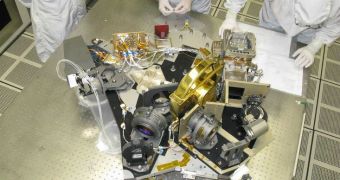Officials at the Greenbelt, Maryland-based NASA Goddard Space Flight Center (GSFC) announce that they have just received an engineering test unit for the Near Infrared Camera (NIRCam) instrument. The final version of the device will go on the space agency's new mammoth observatory, the James Webb Space Telescope (JWST). The satellite will replace Hubble as the main eye-in-the-sky NASA operates within a few years. The NIRCam instrument will spend the next year in a GSFC clean room, where it will undergo extensive testing and evaluations, scientists here say.
The observations instrument, which is designed to observe the early Universe in a wavelength range of 0.6 to 5 microns, is being built by a collaboration of scientists at the University of Arizona and Palo Alto, California-based Lockheed Martin Advanced Technology Center. The leader of the effort is UA professor of astronomy Marcia Rieke. The engineering test unit (ETU) that was delivered to Goddard is basically nothing less than a fully-functional replica of the actual NIRCam instrument that will go on the JWST. The device experts will test can also perform certain flight functions, researchers say. Testing it is very important as this machine will be the primary instrument on the behemoth observatory.
“The NIRCam ETU includes one fully functional optical channel and was used to demonstrate the hardware to be used in aligning the Webb telescope's mirror segments,” explains Marcia Rieke, who is also the principal investigator for the instrument. After GSFC researchers are finished tinkering with their new toy, they will also practice installing it onto the heart of the telescope, the Integrated Science Instrument Module (ISIM) structure. This experience will come in handy when the actual camera needs to be placed in its final position. If any problems occur during installation, they will be solved using the ETU, experts add.
“A lot of hard work went into developing and testing the NIRCam ETU. We are excited to have it here at Goddard for ISIM testing. This brings us one step closer to achieving the science goals of NIRCam and the Webb telescope,” explains GSFC NIRCam Instrument Manager Diane Yun. The actual camera will arrive at the NASA facility no earlier than 2011, for final testing and integration onto the actual telescope. When all this work is complete, NIRCam will have to share ISIM with the other three main instruments that will form the heart of the observatory.
The James Webb Space Telescope will follow the tracks of ESA's new Herschel and Planck observatories. It will be inserted into a solar orbit around the Lagrangian point L2. It will orbit some 1.5 million kilometers further away from the Sun than the Earth does, and will be protected from residue light and UV radiation via a single radiation shield. This will allow it to peer as far back in time as possible, possibly to the beginning of the Universe, when the very first structures started populating the newly generated void.
The ISIM Thermal Control Subsystem, the ISIM Control and Data Handling Subsystem, the ISIM Remote Services Unit, the ISIM Flight Software, the ISIM Electronics Compartment, and the ISIM Harness Assemblies are also among the Goddard-designed subsystems that are critical to the normal operation of the telescope's instruments. The JWST is a joint project of NASA, the European Space Agency (ESA) and the Canadian Space Agency (CSA).

 14 DAY TRIAL //
14 DAY TRIAL //